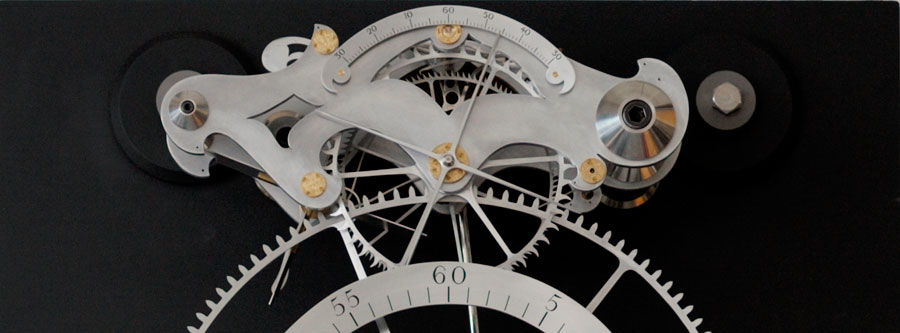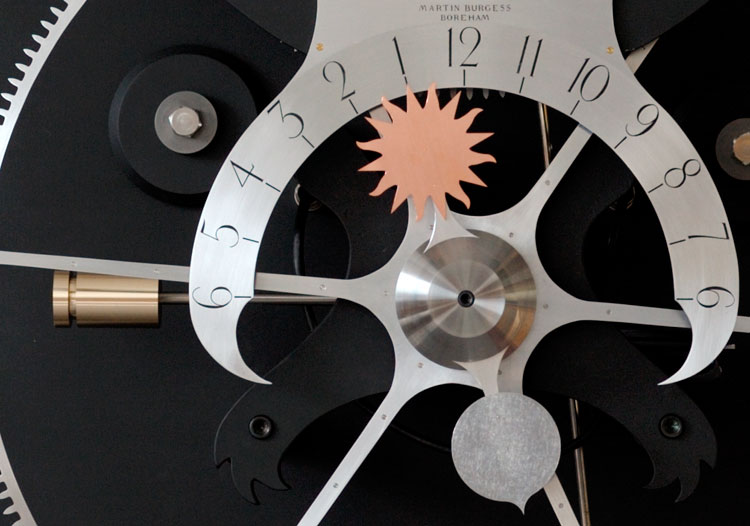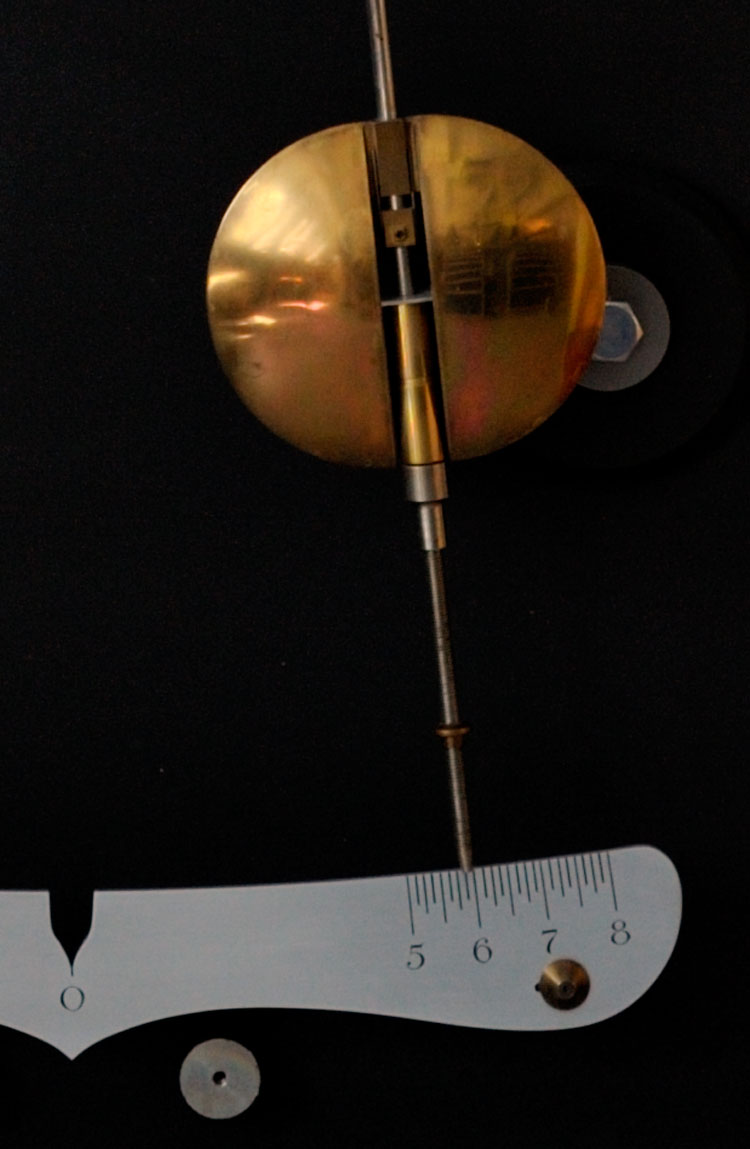
Martin Burgess, Regulator ‘B’
In 1975 the artist and clockmaker Martin Burgess, was commissioned to make a sculptural clock for Gurney’s Bank of Norwich. He saw this as an opportunity to explore John Harrison’s 18th century precision time keeping technology. Ultimately the project involved a number of horologists, who formed the Harrison Research Group to look at his theories afresh. Harrison had claimed that his earlier pendulum clocks were accurate to within one second per month and that his last, unfinished clock, “…shall perform to a second in 100 days”.
Martin Burgess started to make two clocks based on Harrison’s principles, but using modern materials where this was considered appropriate. Clock ‘A’ was completed in 1987 and is now the property of Norwich City Council. Clock ‘B’ was never finished and its parts lay dormant in Martin Burgess’s workshop for over thirty years. In 2009, it was bought by a collector and Charles Frodsham & Co. were commissioned to complete the work.
This entailed research into Martin’s initial objectives, and lengthy discussions with the new owner of the clock. We also had lots of input from Martin Burgess and his colleague Mervyn Hobden on their experiences with Clock ‘A’.
The clock was designed to be weight driven and, like Clock ‘A’, the driving weight was made to be re-wound electrically. Clock ‘A’ has a conventional cylindrical driving weight which is periodically raised by a chain, whilst in Clock ‘B’ we designed a drive using a gravity arm. The geared motor is virtually silent and raises the gravity arm approximately every twenty minutes. This arrangement is very unobtrusive and does not detract from the visual impact of the clock with its large train wheels and the seconds pendulum swinging through an arc of 12 ¼°.

The train wheels are made of Duralumin and all run on oil free ball races. The pinions are Harrison’s form of lantern pinions but use small ball races in place of lignum vitae rollers. The second wheel pinion needed completing and ball races fitting. One of the remarkable features of Harrison’s clocks (also known as his regulators) is that they do not require lubrication. This is the same with the Burgess regulators and Clock ‘A’ ran with virtually no attention for some 25 years.
Although weight driven, the escape wheel is driven directly by a remontoire, a coiled spring, that is rewound every thirty seconds. This isolates the escapement from variations in torque from the gear train and also means that the recoil of the escape wheel just rewinds the remontoire spring rather than the whole train.
Martin had originally made both clocks using ball races for all the pivoting elements of the escapement, but subsequently found that those particular ball races were not suited to reciprocating motion. This had caused problems in Clock ‘A’ and the ball races were changed to Nylotron plain bearings and the pallet crutch to a knife edge resting in a V notch in quartz pads. Frodshams carried out similar work on Clock ‘B’ making a new pallet arbor resting on sapphire pads and using low friction PEEK for the pallets and composer bearings.
The cycloidal suspension cheeks are a very important part of Harrison’s regulator theory, and these cheeks needed to be made for Clock ‘B’. They were precision milled from large brass blocks that are bolted to the massive 90kg steel back plate. The radii of the cheeks are critical and as Martin and Mervyn had established this, we made the cheeks to the values they suggested.
A lot more work was required in completing the drive to the hands, the dials and the hour, minute and seconds hands. The aesthetics were carefully considered with the owner and the clock was finished accordingly.

After some initial adjustments and regulation, the clock was found to be extremely stable, and capable of keeping a good rate. Subsequently it was delivered to the Royal Observatory Greenwich where it undertook independent testing. Clock ‘B’ was set going on 1 Apr 2014 and the case was sealed by representatives from the National Physical Laboratory and the Worshipful Company of Clockmakers. It remained untouched in the case and on the 6 Jan 2015 was verified as indicating UTC -1/4 second. This marked the beginning of the official trial. 100 days later the clock error was -5/8 of a second with a maximum deviation of ¾ of a second throughout that time. Accordingly, Guinness World Records awarded the clock the distinction of being the “most accurate mechanical clock with a pendulum swinging in free air”.
Clock ‘B’ has now been relocated at Greenwich and is on public view in the Time and Longitude Gallery, at the Royal Observatory, alongside the iconic John Harrison timekeepers.
The National Maritime Museum has held three 1-day conferences on Burgess Clock ‘B’, the proceedings of which will be published in 2018:
- Decoding Harrison, 12 Jul 2014
- Harrison Decoded, 18 Apr 2015
- Revolution in Time, 5 Oct 2016 (in collaboration with the Institute of Physics)

